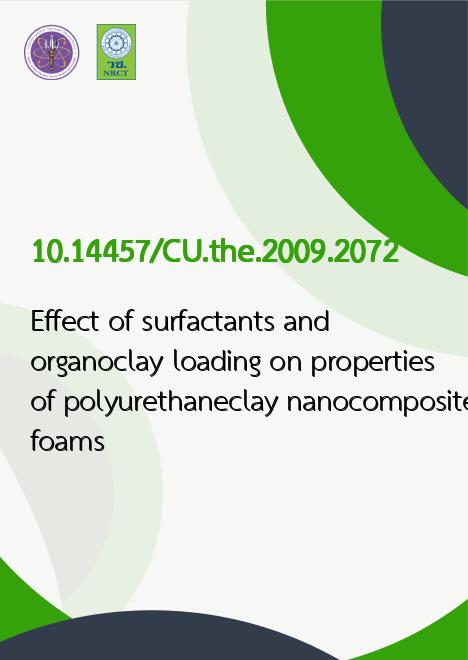
|
Effect of surfactants and organoclay loading on properties of polyurethane/clay nanocomposite foams |
|---|---|
| รหัสดีโอไอ | |
| Title | Effect of surfactants and organoclay loading on properties of polyurethane/clay nanocomposite foams |
| Creator | Sevita Inthapichai |
| Contributor | Anongnat Somwangthanaroj |
| Publisher | Chulalongkorn University |
| Publication Year | 2552 |
| Keyword | Clay, Polyurethanes, Nanocomposites (Materials), Isocyanates, Surface active agent, Fourier transform infrared spectroscopy |
| Abstract | The present study emphasized on adding organoclay as filler in flexible polyurethane foams to reduce the usage of raw materials which affect the environment such as isocyanate. Two types of clay that were used in this study were in nanometer range. However the difference of ability to exchange cation and the amount of free silica within the clay are observed. Furthermore, the effect of chemical structure of surfactant and the effect of mixing sequence between nanoclay and monomer as well as organoclay loading on the degree of clay dispersion in polyurethane/clay nanocomposite foams are investigated. The results show that the organoclay which was treated by hydroxyl group surfactant shows the highest d-spacing of layered silicates and clay particles did not interfere with hydrogen bond formation as evidenced by fourier transform infrared spectroscopy. The investigation of mechanical properties such as hardness test, resilience test and compression set test show that hardness of polyurethane/clay nanocomposite foams is higher than that of pure polyurethane foam but resilience and compression set properties show lower value compared with those of pure polyurethane foam. Furthermore, the investigation of thermogravimetric analysis of polyurethane/clay nanocomposite foams showed that the nanocomposite foams is higher thermal degradation temperature because the silicates served as a thermal barrier for delaying the hard segments from degradation during heating. Nevertheless, the improvement of the properties depends on clay dispersion ability in the polyurethane matrix. Good dispersion of clay is observed at low organoclay content. |
| URL Website | cuir.car.chula.ac.th |